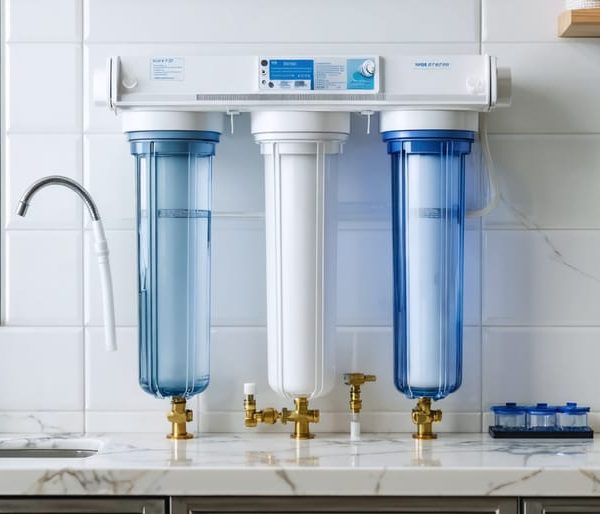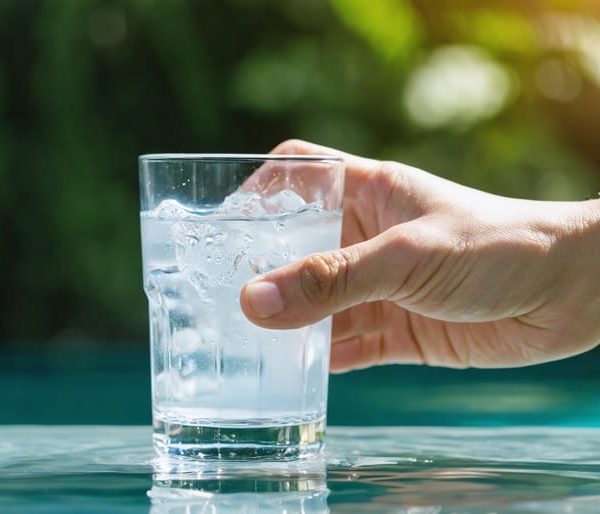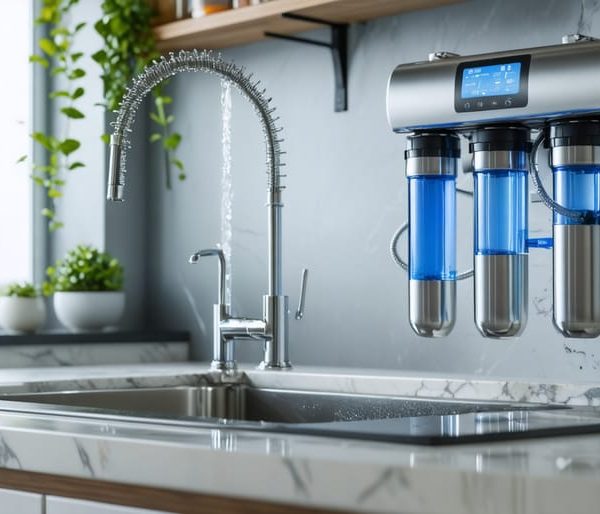TDS means Total Dissolved Solids, defined as the overall concentration of inorganic salts and a small number of organic compounds dissolved in drinking water. The TDS levels affect the water quality and taste.
Examples of such inorganic elements include sodium, potassium, calcium, and magnesium. These are cations (positively charged minerals). Total dissolved solids (TDS) that are negatively charged minerals (anions) include nitrates, bicarbonates, carbonates, sulfate, and chloride.
Total dissolved solids (TDS) can be measured using a TDS meter, measuring the TDS levels or quantity/volume.
However, TDS meters don’t detect the nature or type of total dissolved solids contained in the water. It won’t reveal if the total dissolved solids are toxic organic compounds or vital minerals. You may send a water sample to a laboratory or your local water testing center for an accurate result.
This article will comprehensively discuss the concept of total dissolved solids (TDS) and why they are essential for measuring TDS levels.
How Does TDS Dissolve in Water?
Total dissolved solids can end up in the water due to man-made or naturally occurring events. Water sources such as mineral springs, deep wells, and artesian wells usually contain a high TDS level.
Water from springs has a high TDS level because the water comes from a place where the rocks are rich in mineral salts. Hence, the water picks TDS along the way.
Well water also has a high TDS level because the water is coming from a place that’s rich in various minerals.
Then due to the urban and agricultural activities of humans, it seeps into water sources. There’s also wastewater from reverse osmosis systems and water softeners after regeneration, including calcium and magnesium, then potassium and sodium (depending on what the softener uses).
TDS also comes from wastewater flushed out from water treatment plants and salts that thaw the roads during winter.
Rainwater is an excellent example of low TDS water because it comes straight from the sky without going through multiple layers of the soil picking up minerals along the way.
However, in the coastal regions, rainwater may be slightly more salty than normal due to the evaporation of seawater nearby. Rainwater is also soft and has a slightly acidic pH because it has absorbed carbon dioxide in the sky.
Factors Determining the Levels of Total Dissolved Solids Present in Water
- The abundance of minerals in that particular geological location.
- The solubility of these minerals in the water.
- The duration of contact between the water and the mineral source.
What Happens to Water With a High TDS Level?
Naturally, a strong presence of total dissolved solids is not harmful to one’s health. Some people prefer this kind of TDS water which is popularly referred to as mineral water.
The Environmental Protection Agency in America, which has been tasked with drinking water regulations, has included TDS as an auxiliary standard. This means that TDS has a guideline.
While the agency prescribed legal standards for harmful substances, total dissolved solids with technical, cosmetic, and aesthetic effects have only been prescribed a guideline.
How Much TDS Water Is Safe for Drinking?
A TDS meter measures TDS in drinking water in units in ppm (parts per million). The ideal TDS level for drinking purposes is between 75-90 ppm. However, a TDS level anywhere between 50-150 ppm is also considered safe for human consumption.

Water with low TDS levels is known to have a flat taste, which many people don’t fancy. Higher TDS levels in drinking water make the water taste better. However, an intense concentration of certain dissolved minerals in other kinds of water can produce hard water, which leaves soap scum and scales on fixtures and surfaces in the home.
High levels of total dissolved solids can also affect appliances, especially water heaters and boilers. Water with a very high volume of total dissolved solids (TDS) can leave spots on your kitchenware, cause corrosion in your water pipes and cause your water to taste like metal.
Hard water can make water filters wear out before long due to the quantity of minerals.
The presence of minerals or TDS in water may also indicate that there are harmful contaminants in the water that are harmful. This is typical of water that acquired TDS through man-made pollution, such as wastewater from water treatment systems.
Such contaminants include bromide, sulfate, arsenic, iron, and manganese.
TDS Guidelines
In countries such as Canada, there is a term known as Maximum Acceptable Concentrations (MAC). It lists substances that can be a health hazard in higher quantities. It is a crucial guideline in the Canadian drinking water regulation.
For substances such as TDS that are not considered harmful in their maximum acceptable concentrations, they are prescribed as an aesthetic objective in the guideline.
The guideline in Canada for minerals is below 500mg per liter, which also means 500 parts per million.
Despite the provisions, it is only a guideline and not enforced as each Canadian province is allowed to act according to the guidelines or not.
A province known as Saskatchewan is an area with naturally occurring high TDS levels that doesn’t concur with the 500 mg per liter guideline. So instead, it follows its own guideline of 1500mg per liter.
In the U.S., their standardization term is known as “Maximum Contaminant Levels,” and it is enforced. TDS and other elements considered to have an aesthetic effect are prescribed with Secondary Maximum Contaminant Levels, which is not enforceable.
This is because they don’t establish the major contaminants as a health hazard.
The guideline in the U.S for TDS is 500 mg l.
Why Should You Measure the Level of Dissolved Ions or TDS in Water?
It is recommended that you measure the water quality before using it. Below are the reasons you should to measure drinking water quality to know the TDS level:
Taste
The concentration level of TDS influences the taste of your water. Water with low TDS is tasteless, while water with high levels of mineral ions can taste salty, bitter, or even sulphuric. The difference in the taste of the water is due to the type of mineral ions contained in the water.
Stomach Experience
It’s good to know the water TDS level when you want to pair your drinking water with other beverages such as Whiskey, which goes best with water with a very low level of total dissolved solids.
Drinking water with low levels of total dissolved solids combines well with light foods. For example, the consumption of red meat combines well with drinking water that has high mineral content. The high mineral content lends weight to the food and complements its strong flavor.
Maintenance of Water Systems
Water filtration systems are not immune to the high levels of mineral ions contained in the water. Over time, the minerals in the water can wear out these water systems unless the water is regularly measured/tested to keep the water system in optimal shape.
Health
Water rich in minerals is very safe for drinking, but it can trigger health complications when it contains elements such as copper or lead.
The essential minerals like calcium, magnesium, potassium, and sodium are suitable for the body as long as they are not excessive.
People who wish to improve their daily intake of these essential minerals can consume mineral water.
On the other hand, water with low TDS lacks the essential minerals but comes with the perks such as hydration of the body.
Cooking Purposes
It is essential to measure TDS in the water you want to use for cooking because water rich in minerals can change the taste of your food.
Cleaning Purposes
High TDS produces hard water, leaving spots on dishes when used to clean them. It will also trigger scale buildup and soap scum on surfaces it cleans.
On the other hand, if your tap water has low TDS, it won’t trigger the development of soap scum and scales.
How to Reduce TDS from Water?
Reverse Osmosis
The reverse osmosis filter removes excess minerals from water and produces treated water that’s acceptable for drinking and good for one’s health.
It uses pressure to force water through an artificial membrane. This membrane has nano-sized pores that are smaller than 0.0001 microns.
The reverse osmosis system can reduce total dissolved solids because the minerals and other contaminants in the water are bigger than the pores of the membrane. This enables the membrane to trap them while letting the water flow to the other side.
The RO system is commonly used to produce bottled mineral water.
Deionization
This is the process of removing mineral ions (cations and anions) from the water through an electrode. The membrane used by the deionizer is selective of ions.
It separates the cations from the water by drawing them to the negatively charged electrode.
This results in the production of very pure water. Before water is deionized, it is first filtered through reverse osmosis to eliminate the organic compounds in the drinking water.
Distillation
This is the process of boiling water to release a vapor which is then trapped and collected. When it condenses, pure water enters the receptacle. Distilled water is free of dissolved minerals.
TDS vs. Water Hardness
One should not mix the total dissolved solids and hardness in water because they’re not the same. For example, a body of water can have a high TDS level, categorized as soft water.
Hardness is primarily determined by the volume of calcium and magnesium contained in the water. They can be in the form of sulfates, chloride, or bicarbonates.
On the other hand, TDS isn’t limited to the presence of calcium and magnesium but other minerals. Total dissolved solids also comprise zinc, potassium, sodium, and so many others.
TDS water may not produce soap scum and leave scales in the home, whereas that’s a certainty with hard water.



